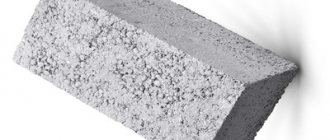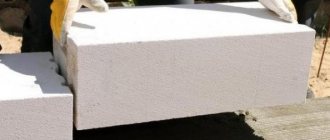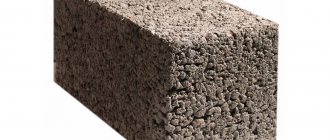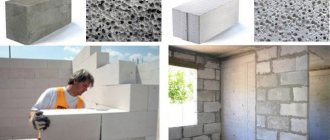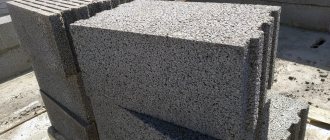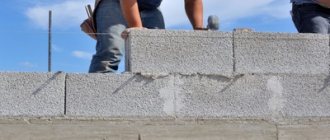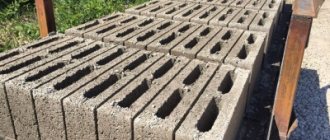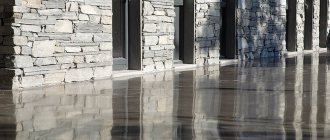This building material is popular, which is explained by the peculiarities of its properties and quality characteristics. Most likely, most frequent developers even planned the option of building from such blocks. As is the case with other building materials, certain requirements are imposed on expanded clay concrete. Therefore, today we will figure out what the GOST standards for expanded clay concrete blocks say.
Types of blocks according to GOST
Expanded clay concrete is used for the construction of walls. The prepared mass, which meets the requirements for certain characteristics, is poured into molds. After this, she is given time to harden. Each element has a through or non-through type of slot inside.
In accordance with GOST, expanded clay concrete is divided into:
- Full-bodied. There are no holes or cracks inside. The exception is special holes for convenient transportation of material.
- Private. These blocks require subsequent finishing of the entire surface.
- Facial. They have decorative coatings on one or two sides. Used in construction and as a facing material.
Note that blocks with grooves connect much better, increasing the strength of the entire structure.
GOST for expanded clay concrete blocks establishes the division of the material according to the textural differences of the surface into:
- Chipped - the surface of the elements does not differ in evenness. Excesses can reach eight millimeters;
- Corrugated - the blocks are processed, the surface combines depressions and protrusions;
- Polished – the sides of the element are rough:
- Smooth – the coating is the same on all sides.
Concrete wall stone
Technical characteristics of expanded clay concrete blocks GOST 6133 99 are as follows:
- dimensions (cm) – 39 x 19 x 18.8;
- block weight – from 14 to 16 kg;
- compressive strength indicator – M-35 V 2.5;
- frost resistance – F 25;
- ability to conduct heat – 0.43 W;
- in terms of radioactivity level – corresponds to the norm;
- density value - from 950 to 1000 kg per cubic meter;
- density indicator of the concrete mass - from 1,250 to 1,300 kg per cubic meter;
- categorized according to group A-7.
BLACK FRAMEWORKS
| In this regard, the main point of view is large format (5-10 mm), using the same format . BELOVED ESSAYS **KYYYYYYYYYYYYYYYYYYYYYYYYYYYYYYYYY aroundMENT obasov, this is the world, and this is the world. yoyo, ssásía îàãðåâàíè ëåsîà è sîõðàíåò sòåïîîîîà, súsías in other words, in other words, in other words. About this system and this system this is the case with the kikor. That's it, that's it, that's it, that's it. CORRESPONDENCE OF FOLLOWING AND CLASSIC Familiarity. Terminology Printing size 65 kg/q.cm. Price 1240 kã/m.kóá. Value 0.327 V/m. fiia). Valuation and conscience. Existing facades CONCLUSIONS more information Belyov Fofan BELOV FOFAYE Note: Kåðàmçèò moreover, this is the case with the Russian Federation. formats In this case, you can use this information this is 3 rounds, 2 rounds and 2 rounds çà ómåíüøèòú çàòðàòû íà ðàáî÷óþ ñèóó, â 4.75 ðàç óìåíüøèòú çàòðàòú “íà ï” this is the case. The Komsomolskaya Pravda and the All-Russian Basilicas this is the case with the Russian Federation and the Russian Federation e. This is the case with the Russian Federation (the Russian Federation and the fáfææíàÿ gãoèía.), vâîäà i öåmåíò. In other words, this is the case with this system. Sonia Solovyov, Slovakia Gagalov, Sasha Vasilyova sòü. Kårðàmçèò, îáëàäþùèé vâûñîêîîîîñîþèèèåãêîñòüþîîîîêîîñî this is the case with the world. The range is 400 to 1800 kW/m3. Distribution In other words, this is what we mean by this word. Case study in this area, in other words synonymous with the world. Keywords to this topic: what's more, what's the point? this is the same as in other words. This is the case with the Russian Federation. this is the case in this regard, in the same way as in Asia Yúy ñðä, êàê ðàñòâvîû ñóëüfàòîâ, åäêk ùåëî÷åé, ógàñåkèñîòû, ìúêîé â” f.îäû and t.ä. Establishment of the Russian Federation in Russia this is the meaning of the term. In addition to this, this is the case format and ip. |
Tips for choosing material
There are several features that must be taken into account when purchasing expanded clay concrete material:
- GOST for expanded clay concrete specifies that Portland cement is used for production, the grade of which is not lower than M 400. The fact is that only it can provide the required strength;
- if the building material is planned to be subjected to heat treatment, then alite cement is used;
- in production, quartz sand can be used, which increases strength, expanded clay gravel, which does not contain sand impurities, and a hydrophobic cement composition, which reduces the ability of the material to absorb moisture.
To prevent a decrease in the strength of expanded clay concrete blocks, plasticizer additives are not used.
Material parameters
GOST 6133 99 for expanded clay concrete blocks determines the quality of products. Only here you can find all the technical parameters inherent in expanded clay concrete blocks.
According to its intended purpose, the material is used in the construction of external or internal walls, and for the cladding of finished objects. Based on its purpose, the block can have either one front surface or two – on the side and the end. GOST “concrete with expanded clay” determined that the front side can be processed in different ways. Sanding of the block surface is carried out solely according to the preference of the buyer.
According to shades, expanded clay concrete block can be without color or painted in different colors due to the addition of special compounds.
Each block is made in a parallelepiped shape, but taking into account the wishes of the customer, the shapes can vary.
The end parts of the blocks can be smooth, have grooves or notches. A corner type element can be made in a rectangular shape or have a rounded shape. The mass of one block, regardless of its type, should not exceed thirty-one kilograms.
When a block with voids is considered, its outer wall thickness should not be less than two centimeters, which coincides with the dimensions of internal partitions. As a rule, this requirement applies to blocks with through slots. If the voids are not through, then the internal partitions can be about one centimeter thick.
The compressive strength value for an expanded clay concrete block varies, ranging from 50 to 300 for elements made of heavy concrete compositions, and 100 to 25 for material made from light concrete mass.
The frost resistance class is determined for materials that are intended for the construction of external walls, because they are the ones who will be exposed to cold masses.
The level of fire resistance is important. Expanded clay concrete blocks belong to A 1. This means that the material exposed to an open flame begins to collapse after seven to ten hours.
Although the quality characteristics are high, expanded clay concrete blocks must not be used in direct contact with soil compounds.
The vapor permeability indicator today is of particular importance, determining the final choice of building materials. Expanded clay concrete blocks conduct air flows through their voids much better. An object built from this material will have a comfortable indoor climate, even when the level of ventilation is insufficient.
There are two main standards for sizes:
- wall – 39 x 19 – 18.8 cm;
- septal – 39 x 9 x 19 cm.
APPENDIX B (recommended)
Shape and dimensions of concrete wall stones and void sizes
Figure B.1
— Ordinary wall stone
Figure B.2
— Ordinary wall stone
Figure B.3
— Additional ordinary wall stone (three-quarter)
Figure B.4
— Additional ordinary wall stone (transverse half)
Figure B.5
— Additional wall stone with a quarter
Figure B.6
— Additional ordinary wall stone (half and a quarter)
Figure B.7
— Partition stone
Figure B.8
— Partition stone
Figure B.9
— Ordinary wall stone with through slot voids
Figure B.10
— Additional ordinary wall stone (transverse half and a quarter)
Figure B.11
— Decorative front stone with a “ragged” stone edge — “rocky” texture
Figure B.12
— Decorative corner facing stone
Figure B.13
— Decorative facing stone with corrugated texture
Figure B.14
— Ordinary wall stone
Figure B.15
— Ordinary wall stone
Figure B.16
— Decorative front stone with a “ragged” stone edge — “rocky” texture
Figure B.17
— Ordinary wall stone (longitudinal half)
Figure B.18
— Ordinary wall stone (longitudinal half)
Figure B.19
— Stone for the chimney
Figure B.20
— Ordinary stone for ventilation ducts
Figure B.21
— Stone for ventilation ducts
Block material marking
To correctly select expanded clay concrete blocks, it is recommended to understand the brand markings, which in abbreviated form indicate the main technical parameters. It consists of a certain set of letters and numbers:
- first comes the letter “K”, which determines that the material belongs to the group of stones of artificial origin;
- the next two letters determine the area of application of the material (S, P, L, R - wall, partition, front, ordinary). This is very convenient for customers who need finishing;
- the fourth and fifth letters indicate the purpose of the block material in the masonry (UG, PR, PZ, PS - corner, decent, for tying seams and hollow;
- the number following the letters in the marking indicates the length of the element;
- After all, there are parameters for the level of strength, resistance to frost and density.
By understanding the algorithm for reading the markings of expanded clay concrete, you will always find the material you need for masonry.
Classification
Expanded clay blocks are divided according to structure:
- Hollow . They are characterized by relatively low weight, have high rates of sound insulation and thermal conductivity.
- Full-bodied . They differ from previous products in their high resistance to dynamic loads. Such blocks can be used for the construction of load-bearing walls or foundations of low-rise buildings.
1 - solid wall block, 2 - 4-slot wall block, 3 - 7-slot wall block, 4 - double-hollow wall block, 5 - partition 2-hollow block.
Blocks are also divided according to purpose. In particular:
- Wall . From the name it is clear that the product is intended for the construction of supporting wall structures.
- Septal . They have less strength and are therefore intended for interior partitions and the construction of non-load-bearing walls.
- Ventilation . Such blocks are provided with technical grooves that simplify the installation of utilities.
It is important to understand that depending on the labeling and purpose, the performance properties of the finished product also change.
Procedure for acceptance, storage and transportation
In addition to physical and technical parameters, GOST also establishes such rules.
The instructions for accepting blocks read:
- blocks must undergo quality control in production;
- acceptance is carried out on the basis of conclusions on testing products for compliance with standards;
- the maximum batch should not exceed 150 cubic meters. It includes products produced during one shift, from one batch of raw materials, similar in quality and properties;
- acceptance tests involve testing for compression, tempering strength, deviations from geometric parameters, and other external characteristics;
- Periodic checks include tests for thermal conductivity, frost resistance, density and sound insulation.
For each batch, accompanying documents are drawn up to verify the quality of the blocks, containing the following data:
- batch number, day of issue and registration;
- GOST number;
- number of products;
- acceptance date;
- strength indicator when tested for compression;
- resistance to freezing;
- density grade;
- manufacturer's address and full name;
- symbol of the product.
Expanded clay concrete blocks can be transported by various types of vehicles. During transportation, it is necessary to comply with the requirements for securing the cargo and its packaging. Loading or unloading material in bulk is prohibited.
Blocks are most often stored on wooden pallets. Products should be protected from exposure to natural phenomena by isolating them with film material. Storage is permitted in both closed and open areas.
APPENDIX1 Reference
1. Thermal conductivity of concrete stones
Table 1
| Name of concrete | Thermal conductivity of concrete stones, W/(m °C), at average concrete density, kg/m3 (for operating conditions A/B) | |||||
| 1000 | 1200 | 1400 | 1600 | 1800 | 2000 | |
| Tufobeton | — | 0,41/0,47 | 0,52/0,58 | 0,70/0,81 | 0,87/0,99 | — |
| Pumice concrete | 0,30/0,34 | 0,40/0,43 | 0,49/0,54 | 0,62/0,68 | — | — |
| Concrete on volcanic slag | 0,29/0,35 | 0,41/0,47 | 0,52/0,58 | 0,64/0,70 | — | — |
| Concrete based on granulated blast furnace slag | — | 0,47/0,52 | 0,52/0,58 | 0,58/0,64 | 0,70/0,81 | 0,83/0,99 |
| Concrete based on fuel (boiler) slags | 0,38/0,44 | 0,48/0,54 | 0,59/0,65 | 0,72/0,78 | 0,85/0,93 | 0,92/1,08 |
| Expanded clay concrete on expanded clay sand | 0,33/0,41 | 0,44/0,52 | 0,56/0,65 | 0,67/0,79 | 0,80/0,92 | — |
| Expanded clay concrete on quartz sand | — | 0,48/0,55 | 0,63/0,69 | 0,72/0,83 | 0,85/0,9 | 0,99/1,13 |
| Shungizite concrete | 0,33/0,38 | 0,44/0,50 | 0,56/0,64 | — | — | — |
Notes:
1. Operating conditions A and B according to SNiPII-3-79.
2. Vtab. Table 1 shows the thermal conductivity indicators of a number of concretes used for the manufacture of efficient and conditionally efficient stones of the SKTs, SKI and SKSh types.
3. When calculating the heat transfer resistance of an outer wall made of solid stones, it is necessary to increase the thermal conductivity value of concrete by 3%.
2.Thermal conductivity of whole stones
table 2
| Name of concrete | Thermal conductivity of whole stones, W/(m °C), at average stone density (including cracks), kg/m3 (for operating conditions A/B) | |||||
| 750 | 900 | 1050 | 1200 | 1350 | 1450 | |
| Tufobeton | — | 0,31/0,34 | 0,37/0,39 | 0,44/0,49 | 0,51/0,55 | — |
| Pumice concrete | 0,27/0,29 | 0,31/0,33 | 0,34/0,37 | 0,41/0,43 | — | — |
| concrete on volcanic slag | 0,27/0,29 | 0,31/0,34 | 0,37/0,39 | 0,42/0,44 | — | — |
| Concrete based on granulated blast furnace slag | — | 0,34/0,37 | 0,37/0,39 | 0,39/0,42 | 0,44/0,49 | 0,50/0,57 |
| Concrete based on fuel (boiler) slags | 0,30/0,32 | 0,35/0,37 | 0,39/0,42 | 0,45/0,48 | 0,50/0,55 | 0,57/0,62 |
| Expanded clay concrete on expanded clay sand | 0,28/0,31 | 0,33/0,37 | 0,38/0,42 | 0,43/0,48 | 0,49/0,53 | — |
| Expanded clay concrete on quartz sand | — | 0,35/0,39 | 0,41/0,45 | 0,46/0,51 | 0,54/0,58 | 0,65/0,69 |
| Shungizite concrete | 0,28/0,30 | 0,33/0,38 | 0,38/0,41 | — | — | — |
Notes:
1. Operating conditions A and B according to SNiP II-3-79.
2. Vtab. Table 2 shows the thermal conductivity values of individual effective and conditionally effective stones used for laying external walls.
3. Thermal conductivity values are given for hollow stones with the dimensions and shape of the voids indicated in the diagram. 1 and 2. The thermal conductivity of stones made from other types of concrete and with other voids should be determined by thermal testing.
4. When calculating the heat transfer resistance of an outer wall made of whole hollow stones, it is necessary to increase the thermal conductivity value by 10%.
3. Thermal conductivity of longitudinal halves of stones
Table 3
| Name of concrete | Thermal conductivity of longitudinal halves of stones, W/(m °C), with average density of longitudinal halves (including cracks), kg/m3 (for operating conditions A/b) | |||||
| 820 | 980 | 1150 | 1310 | 1470 | 1600 | |
| Tufobeton | — | 0,33/0,36 | 0,39/0,41 | 0,48/0,53 | 0,90/0,60 | — |
| Pumice concrete | 0,29/0,31 | 0,33/0,35 | 0,37/0,40 | 0,45/0,47 | — | — |
Concrete on volcanic slag | 0,29/0,31 | 0,33/0,36 | 0,40/0,42 | 0,46/0,48 | — | — |
| Concrete based on granulated blast furnace slag | — | 0,36/0,39 | 0,39/0,41 | 0,43/0,46 | 0,49/0,54 | 0,56/0,63 |
| Concrete based on fuel (boiler) slags | 0,32/0,34 | 0,37/0,39 | 0,42/0,45 | 0,49/0,53 | 0,55/0,60 | 0,61/0,68 |
| Expanded clay concrete on expanded clay sand | 0,30/0,33 | 0,35/0,39 | 0,41/0,45 | 0,47/0,52 | 0,54/0,56 | — |
| Expanded clay concrete on quartz sand | — | 0,37/0,41 | 0,43/0,47 | 0,49/0,54 | 0,59/0,63 | 0,70/0,75 |
| Shungizite concrete | 0,30/0,32 | 0,35/0,38 | 0,41/0,43 | — | — | — |
Notes:
1. Operating conditions A and B according to SNiPII-3-79.
2. Vtab. Table 3 shows the thermal conductivity values of individual effective and conditionally effective halves of stones used for laying external walls.
3. Thermal conductivity values are given for hollow stones with the dimensions and shape of the voids indicated in the diagram. 3. The thermal conductivity of stones made from other types of concrete and with other voids should be determined by thermal testing.
4. When calculating the heat transfer resistance of an external wall made of hollow stones, it is necessary to increase the thermal conductivity value by 10%.
